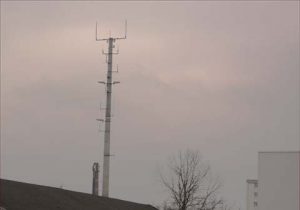 The fire protection authority has recently visited the managers of high-rise buildings or communal buildings more frequently. The fire brigade wants to ensure that the recently introduced digital mobile radio technology TETRA provides consistent reception within the building. As proof the authority wants to have measurements of the field strength of certified engineering offices. If the continuous wireless connection is not confirmed, the owner must provide signal amplification. The central authority for digital radio BOS (Germany) issues a guideline for the planning and realization of object supply. At country level, the guideline is made even more concrete.
The fire protection authority has recently visited the managers of high-rise buildings or communal buildings more frequently. The fire brigade wants to ensure that the recently introduced digital mobile radio technology TETRA provides consistent reception within the building. As proof the authority wants to have measurements of the field strength of certified engineering offices. If the continuous wireless connection is not confirmed, the owner must provide signal amplification. The central authority for digital radio BOS (Germany) issues a guideline for the planning and realization of object supply. At country level, the guideline is made even more concrete.
Analogue radio signals penetrated walls more easily
“With the analogue radio devices, you also had a reception inside a house,” said Michael Kilchert from the department “Preventive Fire Protection” in Bayreuth (Germany) on the phone. “There are some difficulties with digital radio here and there when we are in houses with well-shielding walls.” From a physical point of view, the difference can be explained. Analog radio services transmit in the medium wave range. The longer waves penetrates walls more easily than the relatively short waves of digital radio. The fire department uses the frequency range between 390 and 395 megahertz (MHz). These waves are a bit longer than in private mobile radio. Because LTE transmits in the frequency range around 800 MHz, GSM mobile radio between 920 and 960 MHz.
The building codes of the (German) countries govern the legal obligation for radio in Germany
The building regulations provide, among other things, in the context of the planning permission procedure, that special requirements can be made for so-called special constructions to ensure adequate fire protection. One of these requirements concerns the continuous radio coverage in the entire object. Thus, a list of criteria for special constructions can be found in Article 2 (4) of the Bavarian Building Code. The catalog summarizes such installations and rooms which, because of their height, size, the number or vulnerability of the persons staying in them or for other reasons, present a particular danger potential. These include high-rise buildings, i. buildings over 22 meters high, structures over 30 meters high, buildings of more than 1,600 m² in size of the largest building, excluding residential buildings and garages or sales outlets.
The necessity measurement indicates when an object supply becomes necessary
The owner or the community of owners must prove to the fire protection authority that TETRA digital radio technology works seamlessly throughout the building. The measurements at selected points in the building must be carried out by a certified company. The federal authority for digital mobile radio BOS has set guidelines that can be waived if the installation of an object radio system is adhered to. A secured radio coverage is considered guaranteed if a field strength of 41 dBμV/m or -88 dBm is consistently achieved. The reading refers to the use of an isotropic antenna. If a directional antenna is used, the antenna gain must be taken into account in the results analysis.
The owner does the work and bears the costs
The fire protection authority only demands proof of a functioning radio technology from the slide. Everything else is left to the owner or his manager. This person must first commission and pay for a certified company for the measurement of necessity. If an object supply is necessary, the owner assigns a planning company for the selection of the suitable technology for the radio amplification. After completing the implementation, it must again be measured whether the radio amplification complies with the official guidelines. In particular, the object supply is to be planned according to the minimal principle, i. the interference emission must be so small that the free-field base station is not disturbed. Five-digit EURO amounts are to be planned for the project at least. Anyone who assumes that after successful commissioning of the object supply the thing is done, is taught by the Federal Institute for Digital Radio a better. For if a change in frequency occurs at the free-field base station, then the owner must also have the object radio system adapted to its cost. Also, faults in the system must be immediately reported to the ‘Authorized Body’. Finally, a maintenance contract for the plant must be concluded and submitted to the authority at the latest before commissioning.
Read more about TETRA
TETRA is the short form of Trans-European Trunked Radio System. It is digital private mobile radio standard defined by ETSI. As the major application of TETRA trunk radio system is public safety as well as emergency services. TETRA mobile user can communicate to other users via base station or directly. TETRA user can be assigned one time slot or 4 time slots as transmission bandwidth. These 4 channels can be modulated over one RF carrier frequency.
A better look inside technology (Youtube-Video)
tetrawatch.net – TETRA and health
